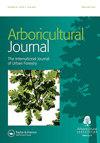Development of a low-cost traffic counter for assessing likelihood of impact for tree risk assessment
Q3 Agricultural and Biological Sciences
引用次数: 3
Abstract
ABSTRACT Most tree risk assessment methods task the assessor with the evaluation of a tree’s likelihood of impact (i.e. likelihood a target is present during failure) when determining the probability that an adverse event will occur. While this is generally accomplished qualitatively based on visual cues; during the 15 to 20 minutes an assessor is at a location, site occupancy, a key component of likelihood of impact, is most accurately measured using traffic counters. The use of traffic counters reduces risk assessment bias and increases reproducibility, though commercially-available devices may be cost-prohibitive. This work addresses one potential barrier to traffic counter adoption through the creation of a low-cost vehicle and pedestrian counting system. The study compares the accuracy and consistency of our homemade traffic counting system to estimates derived from a commercially available system, as well as vehicle and pedestrian counts tallied with a hand clicker. Vehicle and pedestrian counts from the commercially available systems (p = 0.004 and p < 0.001, respectively) correlated well (r = 0.846 and r = 0.896, respectively) with the hand-tallied counts, but the homemade counters were not correlated with either. However, pedestrian counts from the homemade counter became inaccurate as afternoon temperatures went above 31.7°C.开发一个低成本的交通计数器,用于评估树木风险评估的影响可能性
在确定不良事件发生的可能性时,大多数树木风险评估方法都要求评估人员评估树木的影响可能性(即目标在失败期间存在的可能性)。虽然这通常是基于视觉线索定性地完成的;在评估员待在一个地点的15至20分钟内,使用流量计数器最准确地测量了影响可能性的关键组成部分——场地占用率。流量计数器的使用减少了风险评估偏差并增加了可重复性,尽管商业上可用的设备可能成本过高。这项工作通过创建低成本的车辆和行人计数系统,解决了交通计数器采用的一个潜在障碍。该研究将我们自制的交通计数系统的准确性和一致性与来自商业系统的估计进行了比较,以及用手动点击器计算的车辆和行人数量。市售系统的车辆计数和行人计数(p = 0.004和p < 0.001)与手工计数的相关性较好(r = 0.846和r = 0.896),而自制计数器与两者均不相关。然而,当下午的气温超过31.7摄氏度时,自制计数器上的行人计数变得不准确。
本文章由计算机程序翻译,如有差异,请以英文原文为准。
求助全文
约1分钟内获得全文
求助全文
来源期刊

Arboricultural Journal
Agricultural and Biological Sciences-Agronomy and Crop Science
CiteScore
2.40
自引率
0.00%
发文量
28
期刊介绍:
The Arboricultural Journal is published and issued free to members* of the Arboricultural Association. It contains valuable technical, research and scientific information about all aspects of arboriculture.
 求助内容:
求助内容: 应助结果提醒方式:
应助结果提醒方式:


